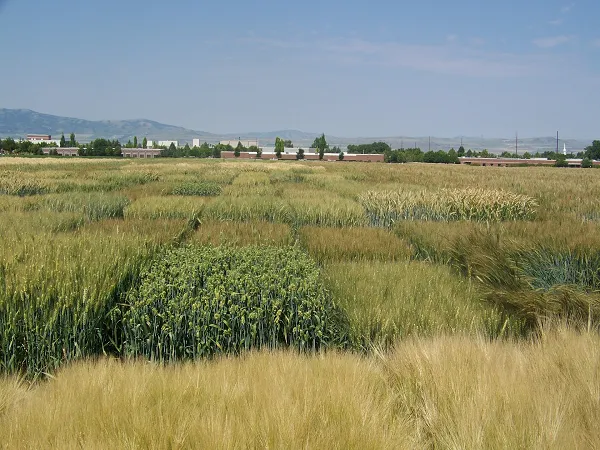To celebrate National Utah Day on May 31, USDA’s National Institute of Food and Agriculture (NIFA) is highlighting the innovative NIFA-funded research conducted by Utah State University’s (USU) Agricultural Experiment Station.
Historical Background
The Utah Agricultural Experiment Station (UAES) was established in 1888 and is the historic foundation of research, teaching and Extension at Utah State University. At research facilities on the Utah State University campus and throughout the state, the UAES supports hundreds of research projects. It operates labs that test soils, plant tissue, irrigation water and livestock feed. It supports research on food safety and processing; plant and animal genetics; and economic and social forces that shape families and communities.

Successes and Innovations
John A. Widtsoe served as director of the UAES and later as president of the Utah State Agricultural College in the early 1900s and championed creating The Deseret Farmer, a popular magazine that shared new agricultural research findings and recommendations directly with farmers using non-technical language. Widtsoe’s research addressed a perennial challenge in Utah: water. With little annual precipitation in Utah, he focused on growing crops with and without irrigation. He authored the books, “Principles of Irrigation Practice” and “Dry-Farming: A System of Agriculture for Countries Under a Low Rainfall” which was used by scientists and farmers worldwide for several decades.
In the 1920s, dwarf bunt disease decimated wheat crops in the western U.S. by turning what should have been seed heads into clusters of dark, foul-smelling fungus spores. Plant scientists at Utah State University began developing and testing new varieties of wheat as quickly as selection for bunt-resistant genes and breeding allowed at that time. They developed wheat varieties that saved growers. There is now a fungicide to help control bunt diseases, but because diseases change and adapt over time, scientists at USU continue to genetically improve small grains with experiments on research farm plots that have served as outdoor laboratories for more than 120 years.
Beginning in the 1970s, USU food scientists developed lactic culture starters that made significant changes in how cheese was and continues to be made worldwide.

NIFA-Funded Research
As part of the nationwide network of Land-grant Universities, USU researchers are committed to improving agriculture; natural resources; economic opportunities; communities; and human, animal, and environmental health. NIFA-supported research and other research provide the science-based information used by Extension specialists and faculty who serve people in Utah’s 29 counties. Utah has wide-ranging geography and climate from mountains and cold temperatures in the north to red rock deserts in the south. Having faculty focused on some of the challenges facing Utahns is important in helping people and communities thrive.
Researchers also collaborate with USDA-supported laboratories on the USU campus that serve people in Utah and nationwide: the Forage and Range Research Laboratory, Poisonous Plant Research Laboratory and the Pollinating Insect Biology, Management and Systematics Laboratory.

Unique Agricultural Challenges
Water scarcity and water quality will always be challenges in the western U.S. The Ag Water Demonstration, Research and Implementation Program (Ag-DRIP), designed to help increase agricultural resiliency to drought and conserve water in the Colorado River Basin, is helping people better manage and conserve water. Ag-DRIP researchers are working with farmers to optimize the use of irrigation water, which means helping them update irrigation techniques and equipment and use better methods of measuring the water necessary to grow specific crops.
Utah has a rapidly growing population and shrinking areas of agricultural land. Commercial and residential development often encroaches on agricultural land or farmers find it difficult or impractical to turn down high prices offered for their land. Agricultural scientists, economists and regional planning researchers are helping communities recognize the value of local agricultural production and are assisting farmers and ranchers to evaluate their operations and consider changes they might make to sustainably increase productivity.
Future Research
While agriculture uses the largest share of the state’s water, it is estimated that 50-65% of Utah's culinary/potable water is used to irrigate landscapes. Research has demonstrated that the amount of water applied to landscapes could be reduced substantially without affecting landscape quality or people’s lifestyles. Water use could be reduced even further if alternative landscape designs and management programs were practiced.
USU’s Center for Water-Efficient Landscaping conducts research on water requirements of trees and turfgrass; effects of short-term drought on landscapes; development and use of drought-tolerant grasses and landscape plants; and characterizing community-wide landscape water demand and use patterns. Outreach programs provide expertise and information to Extension offices statewide, the green industry, water purveyors/institutions and the public.
USU’s Janet Quinney Lawson Institute for Land, Water and Air teams researchers — many with NIFA and USDA support — across science, engineering and social science disciplines to focus on state and regional issues. The institute connects lawmakers and agencies with information and researchers who can help develop data-driven natural resources and public policy. Among the institute’s activities is the publication of an annual report to Utah’s governor and legislators on the state of Utah’s Land, Water and Air.

